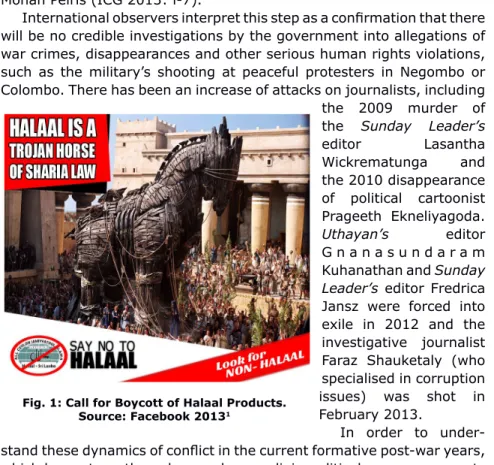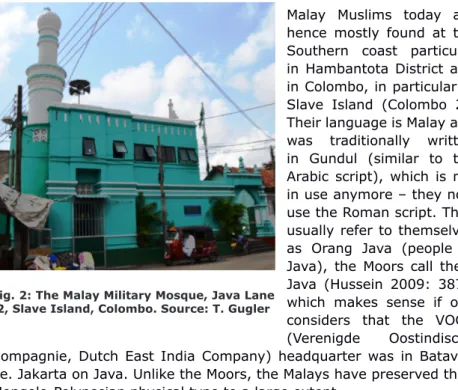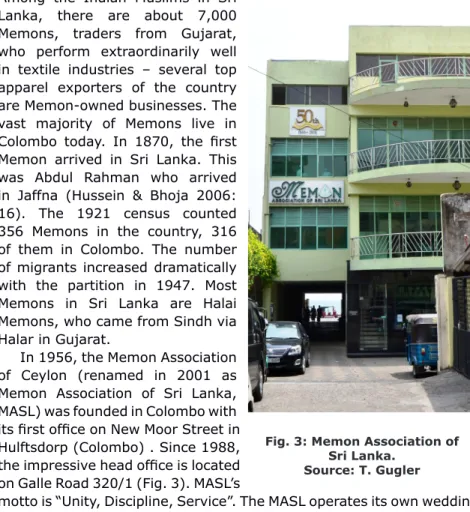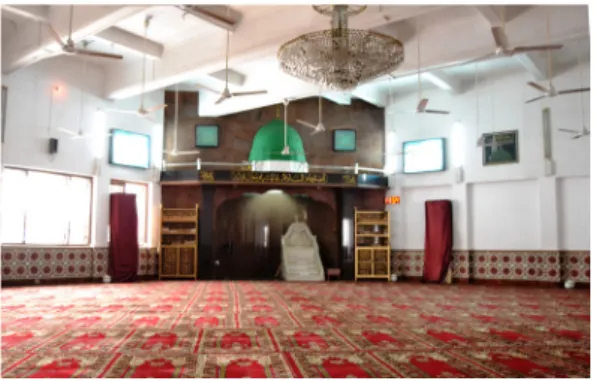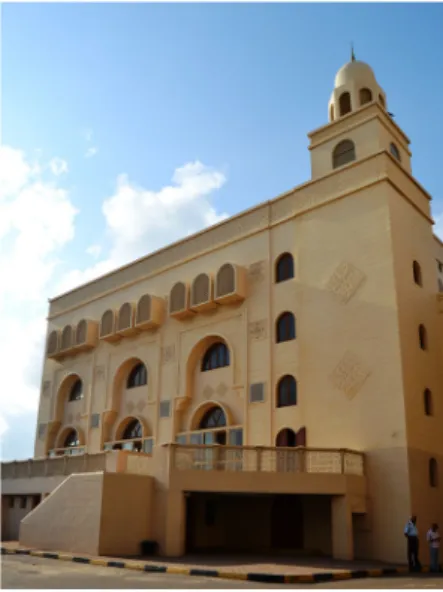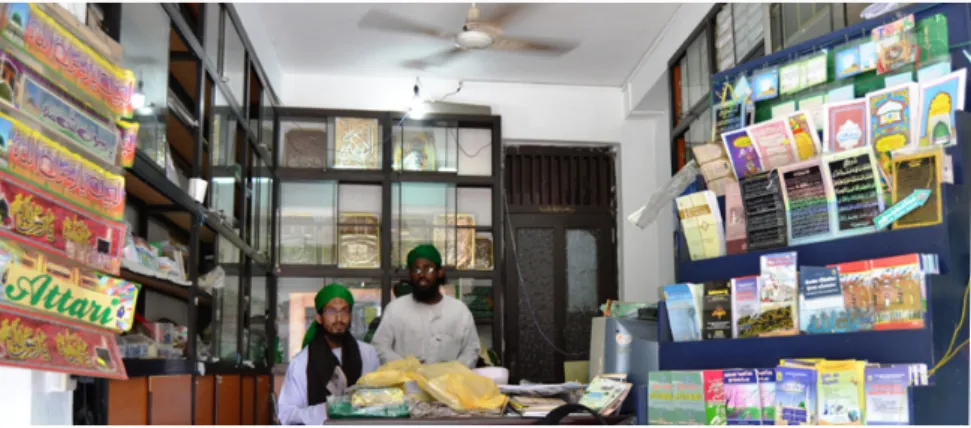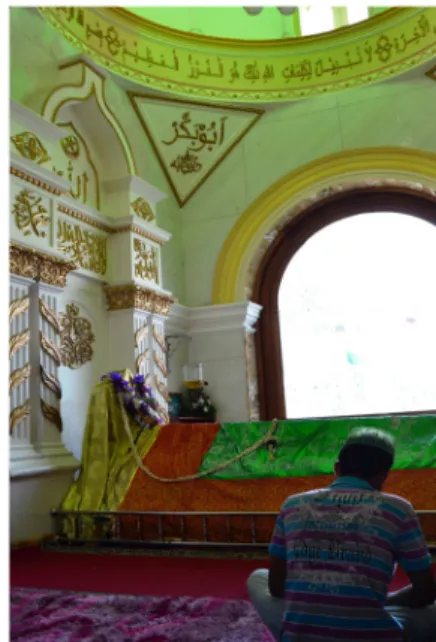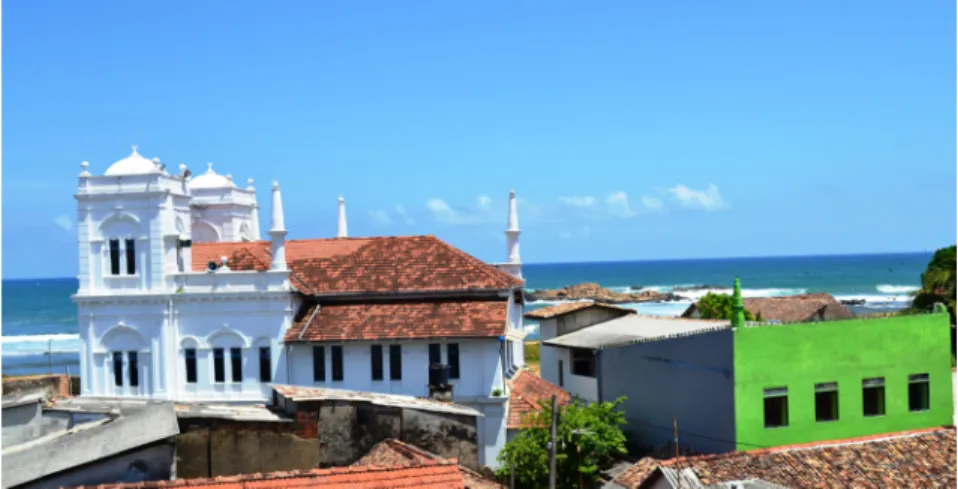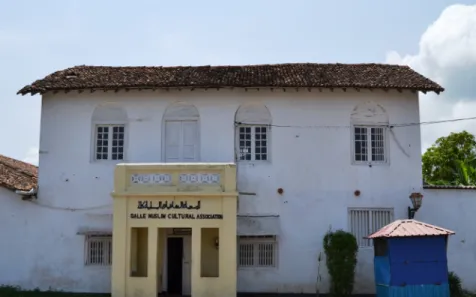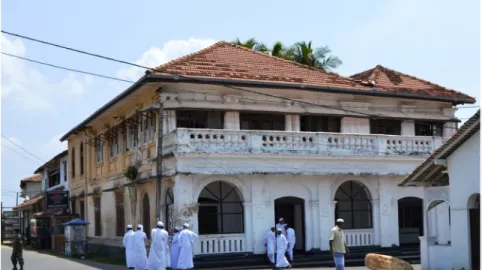161 Buddhist Zion:
Sri Lanka’s Sinhalisation Politics toward its Muslim Minority
THOMAS K. GUGLER thomas.gugler@uni-muenster.de
Introduction
Sri Lanka’s current population is around 21 million people. With approximately ten percent of them being Muslims, Islam constitutes the third most dominant religion in the country. Muslims mostly concentrate in three areas: the coastal areas in the North-East and in and around Galle and Colombo. In 2009, 70 percent of Sri Lanka’s Muslims lived below the poverty line (one US-Dollar per day) and ten percent lived in refugee camps. The present paper aims to briefly sketch the currently increasing conflicts between Sri Lankan Muslims and the authoritarian Buddhist state before going on to introduce the plurality of Islam(s) on the island.
The end of the war in 2009 offered an opportunity for the strongly centralised state to recognise the multi-ethnic and poly-religious character of the country and to overcome the confinement of nation building projects to the Sinhala nation. However, the regime of president Mahinda Rajapaksa – with three of his brothers appointed Defence Secretary, Minister of Economic Development and Speaker of Parliament respectively – failed to adequately address legitimate Tamil and Muslim grievances. Furthermore, a dangerous politics of Sinhalisation and militarisation motivated by an interpretation of the ethnic conflict began to unfold. This was accompanied by a framing of the question of minority rights as a terrorist problem to be dealt with in the way of the ‘War on Terror’. After the military victory over the Tamils, triumphant Buddhist-Sinhalese elements on the extreme right found a fresh target for xenophobia in the Muslim community.
On 12 December 2007, Hassan Ali, General Secretary of the Sri Lanka Muslim Congress, left the government along with three party members to join the opposition and expressed his frustration with the
162
government’s leaders: “It’s noted with deep regret that a Venerable Buddhist monk made a statement recently that the Muslims are not citizens of this country; and that we Muslims have to go back to Saudi Arabia” (cit. in Farook 2009: 104). A similar attitude to that denounced by Hassan Ali appears in Shenali Waduge’s question:
If Muslims claim to want to live ‘peacefully’ why are they undermining this by requesting for laws, practices and customs which directly cause conflicts amongst other communities who are in the majority when they know that in Muslim majority nations non-Muslims have virtually no rights? (Waduge 2013)
“Lankan Muslims must adopt Arabic” was the headline of an article authored by M. I. M. Mohideen, the leader of the Muslim Rights Organisation, and published in The Sunday Leader on 31 March 2013.
Sri Lankan Muslims are ethnically diverse – the Malays speaking Malay, the Bohras speaking Gujarati, the Memons speaking Kutchi or Urdu – but the vast majority being Moor Muslims speaks Tamil, a language that is rather problematical on the paradise island. The ethno-nationalist war turned the Muslims into a community ‘in between’, sandwiched between the Tamil Tigers and the Sinhalese military with both Tamil and Sinhala political elites displaying a strong tendency to exclude Muslims (McGilvray & Raheem 2007: ix). State actors are suspicious of Muslims denying their ‘actual’ Tamil ethnicity for strategic reasons only (Haniffa 2009: 87) and Tamils feel betrayed by the Muslims due to their striving to cooperate with the government.
Sri Lanka suffers currently from growing ethnic tension fed by the denial of minority rights and the absence of power sharing. Attacks by militant Buddhists led by monks on Muslim religious sites – for example damaging the mosques in Anuradhapura in 2011 and Dambulla in 2012 – and businesses owned by Muslims have increased dramatically. Since long, politicised courts have corroded the rule of law – in particular the emergency regulations issued under the Public Security Order and the 1979 Prevention of Terrorism Act override otherwise applicable law – and Sri Lanka’s judiciary has failed to protect both constitutional and human rights, which has increased ethnic tensions (ICG 2009). Annoyed by a number of Supreme Court rulings, the regime of President Rajapaksa and his brothers on 8 December 2012 removed “the last remnants of judicial independence through the impeachment of the chief justice”
163
Bandaranayake, who has been replaced by the presidential legal advisor Mohan Peiris (ICG 2013: i-7).
International observers interpret this step as a confirmation that there will be no credible investigations by the government into allegations of war crimes, disappearances and other serious human rights violations, such as the military’s shooting at peaceful protesters in Negombo or Colombo. There has been an increase of attacks on journalists, including
the 2009 murder of the Sunday Leader’s
editor Lasantha Wickrematunga and the 2010 disappearance of political cartoonist Prageeth Ekneliyagoda.
Uthayan’s editor G n a n a s u n d a r a m Kuhanathan and Sunday Leader’s editor Fredrica Jansz were forced into exile in 2012 and the investigative journalist Faraz Shauketaly (who specialised in corruption issues) was shot in February 2013.
In order to under- stand these dynamics of conflict in the current formative post-war years, which have strengthened several new religio-political mass movements like the Bodu Bala Sena (Buddhist Power Force) fighting new mini-wars like the “boycott halal products” campaign (Fig.1), we will start by shortly looking at the Tamil issue in general that resulted in the current state-supported politics of Sinhalisation and Buddhaisation under mili- tary occupation in the Northern and Eastern Provinces.
1. Hegemony and Majoritarianism: Sinhalisation, Buddhaisation, Militarisation
150,000 soldiers are currently stationed in the North and East of Sri Lanka (ICG 2013: 18). The Tamil-majority Northern Province is currently
Fig. 1: Call for Boycott of Halaal Products.
Source: Facebook 20131
164
de facto under military occupation. The situation in the Eastern Province is similar: The increasing militarisation is accompanied by processes of Sinhalisation: Sinhala signboards are displayed on shops and in public spaces; streets and sometimes even villages are renamed from Tamil to Sinhala (e.g. Kokachankulam village is now Kolobaswewa); monuments of Sinhala war heroes are built; Buddhist temples are erected, even on sites of destroyed Hindu temples, with scores of newly installed Buddha statues in non-Buddhist regions, supposedly for the use of the Buddhist troops; war museums are opened only for Sinhalese people; Sinhalese families are resettled; Tamil civil servants are replaced by Sinhalese officials; ancient Buddhist sites are ‘discovered’ by the government’s archeological department and claims are made on the territory for the establishment of new Buddhist monasteries; contracts for development projects are given to Southern-based companies employing Sinhalese workers instead of local Tamils and so on.
The linguistic Sinhalisation is a convenience for the ten thousands of almost entirely Sinhalese soldiers, who cannot read or speak Tamil, but frightening for the locals, who mostly cannot read Sinhalese and feel that the historically Tamil land is under threat. Muslims also quite correctly feel provoked when Buddha statues are now ostentatiously erected in front of or nearby mosques, as the religious communities traditionally used to keep a respectful distance between their places of worship. Even the flag for the Eastern Province has been changed: The new flag displays three animals representing the three districts with the Ampara district, where Muslims constitute the largest group with 44 per cent (Census 2012) of the population, being represented by the Sinhala lion, which is absurd. Alone in Pottuvil town, Ampara district, where about 99 percent of the population is Muslim, the government in December 2005 indicated seven places as Buddhist heritage sites and threatened the locals in order to make them leave the sacred Buddhist land they occupied. There are now new Buddhist sites for worship with worshipers being conspicuously absent.
Speaking Tamil, many Muslims in the 1980s considered themselves Tamils and supported the Tamil United Liberation Front. Some Muslim youths joined the different militant Tamil organisations. Beginning with the murder of 13 soldiers by Tamil Tigers and the ensuing government- sanctioned anti-Tamil riots in the “Black July” of 1983, the separatist Liberation Tigers of Tamil Eelam (LTTE) was at war with the state, fighting for a state of its own in the Northern province. In 1990 – when
165
the Indian Peace Keeping Forces withdrew – and after some Muslim cadres left the LTTE, the LTTE committed probably its greatest crime by forcefully driving around 90,000 Tamil Muslims out of the Tamil state area, with several massacres being organised in mosques. 1990 was hence a turning point that radically changed Muslim attitudes towards the Tamil cause and its dominant organisations (Farook 2009: 121-152).
In 1995 the LTTE began to set up a de facto state, whose borders were later ratified and quasi recognised internationally through the February 2002 Norwegian ceasefire agreement. In August 2006 another 60,000 Muslims were forced to leave Mutur and there were massacres of Muslims in Pottuvil (Farook 2009: 344-408). In January 2008 the Sri Lanka government abrogated the ceasefire agreement and the war came to a bloody end with the fall of the Tamil capital Kilinochchi in January 2009. The final massacres of civilians and the Tamil leadership continued until May 2009 and about 40,000 civilians were killed just during these final five months of the 26-year long war (ICG 2012c: 5).
Until today, there remain 120,000 internally displaced persons (IDPs), 460,000 IDPs could return so far (since 2009).
Now the area is under military rule, the local politicians are practically powerless. More than half of the population lives below the poverty line, i.e. one US-Dollar per day.2 Over 60 percent of the households are food insecure.3 A study conducted in 2009 in Jaffna displayed very high rates of trauma-related mental health conditions: seven percent of the population suffers from post-traumatic stress disorder (PTSD), 22 percent from depression, 33 percent from anxiety – the rates among the displaced people are significantly higher with 13 percent suffering from PTSD, 42 percent from depression and 49 percent from anxiety (Husain 2011).
In August 2011 the election commissioners decided to reduce the number of parliamentary seats of the Jaffna electoral district. In Jaffna alone, the provincial capital, around 50,000 Sinhalese soldiers are stationed. The military forcibly registered and photographed Tamils.
After objections by the Supreme Court this practice continues under the terms of a police ordinance, which requires residents to register household information with the police – an ordinance not enforced in Sinhala areas. Furthermore, “[T]here also continue to be regular physical attacks on journalists, students, politicians and other political active Tamils in the north, despite – some would say because of – the large military presence” (ICG 2012c: 13).
166
In July 2011 two European journalists from Radio Netherlands Worldwide were attacked and robbed in Jaffna after being intimidated by the police, who told them to leave the province. The military is the final authority on virtually all major decisions – fostering fear, tight surveillance and an atmosphere of strong physical repression.
Tamil fishermen for example suffer from additional military registration requirements that all do not apply for Sinhalese fishermen. The military supports the resettlement of Sinhalese and is building houses instead of barracks. The owners of the private land seized by the military sometimes do not see any compensation or replacement land and there are massive complaints about coerced sales of land. Apart from new army-run restaurants and shops the military began to get involved in the tourist market: The army established hotels and guesthouses in the occupied areas with the air force expanding flights by its commercial wing and the navy opening ferry services. The impact of the military was evaluated as problematic to such an extent that in October 2011 the UN endorsed guidelines that prohibit cooperation and communication between international humanitarian agencies or NGOs and military authorities.
The Eastern Province was hit hardest by the tsunami on 26 December 2004. In the Eastern Province more than 37 percent of the population is Muslim (2012 Census). As another 35 percent of the population is Tamil Hindu, the region is traditionally discriminated by the central Buddhist government in Colombo. The tsunami left around 35,000 people dead in Sri Lanka, more than 500,000 were displaced and about 100,000 houses were damaged or destroyed. The Muslim community was hence hit worst by the tsunami. When the tsunami aid was distributed, the Eastern Province, however, was systematically discriminated since the government focused on rebuilding the less affected tourist and Sinhalese-majority areas in the South first. Although there is enough food for conflict on the table, Muslims generally remain calm as they seemingly have gotten used to suffering from authoritarian rule during the last three decades of emergencies.
2. Plurality of Islam(s) in Sri Lanka: Moors, Malays, Memons The Muslim community in Sri Lanka includes three main ethnic groups: i) the Moors, ii) Malays, and iii) Indian Muslims like the Memons and Bohras.
One third of all Muslims in Sri Lanka live in the Eastern Province. Another fifth lives in Colombo. Muslims are associated with several Southern
167
coastal towns like Galle, where they dominate industries like the gem trade.
2.1. Moors
More than 92 percent of the Muslims of Sri Lanka are Moors, i.e. they trace their ancestry to Arabian traders (Hussein 2011: 1-649; 2009:
345-376). The term Moor is indeed a misnomer and Moors also termed themselves Sonahar, from Tamil Sonagar (lit. skt. Yavanar, fig. a native of Arabia). The term Moor derives from the Portuguese colonial term
“Mauro” meaning being of Arab or Moroccan origin. Prakrit texts from the 5th century refer to the Arab traders as Yonas (from Sanskrit Yavana, lit. Greeks). In Sinhala, Moors are referred to as marakkala minisun (lit. “ship-people”). The Sri Lankan Moors are Shafiites (and not Malikites like the Moroccans). It is important to note that Arab traders were present in Sri Lanka before the advent of Islam in Arabia.
The early Moors dominated the maritime trade, later established pearl fisheries and the gem trade in Sri Lanka. They mixed with Sinhalese and Dravidian locals.
With the fall of Baghdad in 1258 the ties between the Arabs in the Middle East and the Arabs in South Asia were severed heavily and Sri Lanka’s Arabs had little option but to increase commercial and cultural exchanges with the Tamil Muslims of South India (Hussein 2009: 356).
Until the end of the 19th century their literature was generally in Arabu- Tamil, i.e. Tamil written in Arabic script. This came to an end with the circulation of printed books, which were then produced in Tamil script.
Most Moors speak Tamil today, but there remains a sense of pride about their ancient Arab origin and although they must not be confused with the Tamil Muslims, the border has become sometimes fluent.
On a side note, it might be interesting to know that there are probably less than 1,000 Kaffirs in Sri Lanka (Hussein 2009: 441-449), i.e. people of African origin. The Sinhala term Kapiri resembles the Portuguese term Cafre, which derives from Arabic Kafir meaning unbeliever or slave.
African slaves were introduced on the island by the Portuguese after the occupation in 1505 – among the 20,000 soldiers stationed by the Portuguese on the coasts were just 1,000 Europeans, the others were slave soldiers from South-East Africa and Ethiopia (Mann 2012: 88).
They are mostly Christians today.
168
2.2. Malays
About 40,000 (Census 2011) of the Muslims in Sri Lanka are Malays, descendents from Javanese soldiers:
Sri Lanka’s Malays are largely descended from political exiles including nobles and chiefs, soldiers, convicts, and freed slaves from the Indonesian archipelago who were brought over to the island during the period of the Dutch occupation which lasted from 1658-1796. (Hussein 2011: 650).
Malay Muslims today are hence mostly found at the Southern coast particular in Hambantota District and in Colombo, in particular in Slave Island (Colombo 2).
Their language is Malay and was traditionally written in Gundul (similar to the Arabic script), which is not in use anymore – they now use the Roman script. They usually refer to themselves as Orang Java (people of Java), the Moors call them Java (Hussein 2009: 387), which makes sense if one considers that the VOC’s (Verenigde Oostindische Compagnie, Dutch East India Company) headquarter was in Batavia, i.e. Jakarta on Java. Unlike the Moors, the Malays have preserved their Mongolo-Polynesian physical type to a large extent.
Fig. 2: The Malay Military Mosque, Java Lane 2, Slave Island, Colombo. Source: T. Gugler
169
2.3. Indian Muslims
Indian Muslims include Memons, Bohras and Khojas. The Bombay or Gujarati Muslim traders are mostly concentrated in Colombo due to their professional business interests (McGilvray & Raheem 2007: 6).
2.3.1. Memons
Among the Indian Muslims in Sri Lanka, there are about 7,000 Memons, traders from Gujarat, who perform extraordinarily well in textile industries – several top apparel exporters of the country are Memon-owned businesses. The vast majority of Memons live in Colombo today. In 1870, the first Memon arrived in Sri Lanka. This was Abdul Rahman who arrived in Jaffna (Hussein & Bhoja 2006:
16). The 1921 census counted 356 Memons in the country, 316 of them in Colombo. The number of migrants increased dramatically with the partition in 1947. Most Memons in Sri Lanka are Halai Memons, who came from Sindh via Halar in Gujarat.
In 1956, the Memon Association of Ceylon (renamed in 2001 as Memon Association of Sri Lanka, MASL) was founded in Colombo with its first office on New Moor Street in Hulftsdorp (Colombo) . Since 1988, the impressive head office is located on Galle Road 320/1 (Fig. 3). MASL’s
motto is “Unity, Discipline, Service”. The MASL operates its own wedding hall, Memon Hall in Kollupitiya and since 1994 runs its own Madrasa,
Fig. 3: Memon Association of Sri Lanka.
Source: T. Gugler
170
Faiz-e Raza, that is now located together with the library at Perakumba Place, Wellawatte. In 2006, 170 male students were enrolled, and since 1999 there is also the Memon Ladies Madrasa on Hampden Lane, Wellawatte, with 130 students enrolled in 2006 (Hussein & Bhoja 2006:
50-51). They also have their own Qazi to settle disputes according to the Hanafi school of Islamic jurisprudence, and they run their own magazine, The Samachar, in English. Memons’ funerals are simple and speedy, taking place usually a few hours after death at the Maligawatte Muslim Burial Grounds in Colombo. Memons speak mostly Urdu today – a language taught to the children in Faiz-e Raza. Apart from religious activities and the numerous business seminars, the MASL regularly organises cricket tournaments in cooperation with the numerous Memon sports clubs. The principal Memon Mosque in Sri Lanka is the Memon Hanafi Mosque, Third Cross Street, Pettah, Colombo, which was completed in 1939 (Fig. 4). The language of the Friday sermon is Urdu.
2.3.2. Bohras
Bohras and Khojas are Shia Muslims and they number around 3,000 people in Sri Lanka. Bohras are a sub-sect of Ismaili Shia Islam following Syedna Muhammad Burhanuddin (Blank 2001). In Sri Lanka there are four Bohra mosques built by Shias of Indian origin. The oldest one is in Galle, one in Jaffna, one in Pettah in Colombo and the largest and latest one is in Colombo 4. It was established in 2000 and is only accessible to Bohras (Fig. 5).
Fig. 4: Memon Hanafi Mosque, Colombo.
Source: T. Gugler
171
3. Transnational Islam: Tablighi Jamaat and Dawat-e Islami
The Tablighi Jamaat is active in Sri Lanka since the late 1950s. Since 1980 the Tablighi markaz (organisational centre) is located in a building at Lukmanjee Square, Colombo 14 (Fig.
6). The picture shows the mosque, flanked by the residential housings for male travelers on the left – just outside of the compound is another residence for female travelers.
In recent years, Tablighis have faced increased opposition from different directions. While some Muslim activists agreed to declare Tablighis a foreign Wahhabi force, the government of Sri Lanka ordered the first mass expulsion of Tablighi preachers in January 2012, expelling 161 preachers.4
The most important counter-movement to the Deobandi Tablighi Jamaat is the Barelwi missionary movement Dawat-e Islami (Gugler 2011).
The Faizan-e Madinah of Dawat-e Islami in Colombo opened in 2008 on Messenger Street (Colombo 12).
The Faizan-e Madina in Colombo is the single centre of Dawat-e Islami in Sri Lanka.
The movement’s amir (leader), Mawlana Ilyas Qadiri Attar, visited Sri Lanka twice, in 1980 for a missionary journey and in 1999 to visit his sister, who was
Fig. 5: Bohra Mosque, built in 2000 in Colombo.
Source: T. Gugler
Fig. 6: Tablighi Markaz, Colombo.
Source: T. Gugler
172
at this time living in Colombo. The ground floor serves as the mosque and boys’ madrasa, while the second floor hosts the rooms where the boys who study at the madrasa live. They hold – like the Tablighis – a weekly ijtima (congregation) on Thursday evenings with Tamil dars (lesson) and bayan (clarification) (Fig. 7). Next to the Faizan-e Madina is a shop of the Maktabat al-Madina chain selling Dawat-e Islami publications, DVDs and devotional paraphernalia. Besides the publications from India (in Tamil) and Pakistan (in Urdu), so far 15 publications were translated in Colombo into Sinhala – these are printed locally (Fig. 8).
Fig. 7: A 14-year old student of the Madrasat al-Madina giving dars during the weekly ijtima. Source: T. Gugler
Fig. 8: Shop of the Maktabat al-Madina Chain, Colombo. Source: T. Gugler
173
4. Other Mosques in Colombo Established in 1505, the Colombo Grand Mosque is the oldest mosque in Colombo and probably the largest mosque in Sri Lanka. One floor can host 4,500 people. There are three floors plus a basement. On Fridays up to 20,000 Muslim men come to Colombo Grand Mosque to pray.
The dargah (shrine) of Shaikh Usman Walyullah with a mosque is located opposite Odel, Slave Island, Colombo. Pigeons, a symbol of peace, are being fed in front of the dargah (Fig. 10). The green pieces of cloth symbolise wishes placed by Muslims. Every piece of cloth contains a coin. Buddhists perform a similar practice at their holy sites.
Fig. 10: Dargah of Shaikh Usman Walyullah. Source: T. Gugler
Fig. 11: Dua (invocation) at the grave of Shaikh Walyullah.
Source: T. Gugler Fig. 9: Colombo Grand Mosque.
Source: T. Gugler
174
5. Galle
Galle – pronounced gawl in English and gaarle in Sinhala – is the main and the capital city of the Southern Province of Sri Lanka. Its port was Sri Lanka’s main port for more than 200 years, transforming Galle into a city of traders and travelers. The first specific reference to Galle was left by the Muslim traveler Masudi in the 11th century. Ibn Batuta referred to Galle as Qali when he visited the city in 1344. And the Time Magazine labeled Galle “South Asia’s Latest Boomtown” in its edition from 3rd March 2003. Galle’s long-time librarian, Norah Roberts, authored the often-cited and highly readable history of the city, “Galle: As Quiet as Asleep” (Roberts 1993). Today about 30 percent of the population in Galle are Muslims.
The older part of Galle is dominated by the Dutch Galle Fort, which has been declared a World Heritage Site by the UNESCO in 1988 (Fig. 12).
Commenced by the Portuguese in 1588, but mainly built by the Dutch after 1663, the Galle fort is the largest remaining fortress in Asia, making Galle the best example of a fortified city built by Europeans in South and Southeast Asia. Today about 50 percent of the residents inside the Galle fort are Muslims. The main mosque in town is the beautiful Meera Mosque inside Dutch Galle Fort built in 1909. At the
Fig. 12: View of Galle Fort. Source: T. Gugler
175
very same site there stood a Portuguese cathedral before. The Friday sermon is given in Tamil language.
In 1918 the Galle Muslim Cultural Association was established.
Since 1965 the Galle Muslims Cultural Association (GMCA) is based in a building inside the Fort (Fig. 13). The GMCA has branches in Washington and the UK. It publishes the magazine “The Young Muslim”
and organises festivals like Mawlid to celebrate the birthday of Prophet Muhammad.
The Bahjathul Ibrahimya or Arabic College in Galle was established in 1892 and founded by Sir Mohamed Macan Markar’s mother. Sir Mohamed Macan Markar (1885-1969) was Senator and Minister of Home Affairs from 1931 to 1936. Until today it is managed and entirely financed by the Macan Markar family (Roberts 2006: 50). It was the first Arabic College in Sri Lanka that issued Mawlani certificates, qualifying the recipients to become Arabic/Islamic teachers at private or governmental colleges or become the head or kathi (qazi) of a mosque. Its library is the best in Sri Lanka for Arabic books.
Fig. 13: Galle Muslim Cultural Association. Source: T. Gugler
176
The Arabic College in Galle Dutch Fort teaches currently about 60 Muslims
and educates them as imams or madrasa teachers. The course takes eight years. One of the seven lecturers comes from al-Azhar University, Cairo and is financed by the Egyptian embassy (every three years a new graduate from al-Azhar comes here to teach). There is a hostel for students to board in (Fig. 15).
Fig. 14: Class Room at the Arabic College.
Source: T. Gugler
Fig. 15: Student Hostel of Arabic College. Source: T. Gugler
177
Talapitiya Juma Mosque, Galle (Fig. 16), is an Ahl-e Sunnat mosque. Tablighis are not allowed here. The mosque is about 200 years old. It has three floors and hosts about 2,000 Muslim men on Fridays. There is no space for women.
Juma Qadiriya Mosque (Fig. 17) is the largest mosque in Galle and about 120 years old. It is located in Kandewatta.
The Sufi shrine and mosque at Gintota, Galle (Fig. 18) contains the grave of Shaikh Hussain Wali Allah, who came from South India and died in the 19th century.
Fig. 16: Talapitiya Juma Mosque, Galle.
Source: T. Gugler
Fig. 17: Juma Qadiriya Mosque, Galle.
Source: T. Gugler
Fig. 18: Sufi Shrine and Mosque at Gintota, Galle.
Source: T. Gugler
178
The Mosque in Makuluwa in Galle seems to be one of the oldest in Sri Lanka and is said to be 1300 years old. It is connected to the grave of a Yemeni Shaikh from the 8th century. (Fig. 20)
Fig. 19: Mosque in Makuluwa, Galle.
Source: T. Gugler
Fig. 20: Grave of a Yemeni Shaikh. Source: T. Gugler
179
Conclusion
This brief micro-view on lived Islam in contemporary Sri Lanka is enough to indicate that Muslims have a broad, mixed and vivid distinctive culture with an impressively long history in the country. Just as in Europe the Islam ‘issue’ in Sri Lanka today seems to be a fundamental test for the state with regards to granting equal rights, freedom and recognition to all its citizens. In the case of Europe, however, political and legal systems gradually adapt to and increasingly recognise the relatively new presence of Muslims. In the case of Sri Lanka, in contrast, the political dynamics are moving in the opposite direction,
reifying a more and more Buddhist and Sinhala vision of the state with an understanding of democracy that is dictated by the majority. In the foreseeable future the potential for more conflict in Sri Lanka is hence increasing dramatically. And yet, there are people full of hope, like 26-year old fashion designer Kareem, who converted to Islam from Buddhism two years ago “because Islam is so much more free!”
Fig. 21: Kareem. Source: T. Gugler
180
Endnotes
1 Anonymous. n.d. Say No to Halaal. https://www.facebook.com/
SayNoToHalaal [retrieved: 12.06.2013].
2 United Nations World Food Programme et al. 2011. Food Security in the Northern, Eastern and North Central Provinces:
A Food Security Assessment Report – Sri Lanka, p. 13, http://documents.wfp.org/stellent/groups/public/documents/
ena/wfp243519.pdf [retrieved 13.05.2013]
3 Ibid.: 80
4 Anonymous. 2012. Sri Lanka ‘expels 161 foreign Muslim preachers’. BBC News Asia, 22 Jan., http://www.bbc.co.uk/news/
world-asia-16675086n [retrieved 12.06.2013].
Bibliography
Blank, Jonah. 2001. Mullahs on the Mainframe: Islam and Modernity among the Daudi Bohras. Chicago: University of Chicago Press.
Dewaraja, Lorna. 1994. The Muslims of Sri Lanka: One Thousand Years of Ethnic Harmony, 900-1915. Colombo: Lanka Islamic Foundation.
Farook, Latheef. 2009. Nobody’s People: The Forgotten Plight of Sri Lanka’s Muslims. Colombo: South Asia News Agency.
Ghassem-Fachandi, Parvis. 2012. Pogrom in Gujarat: Hindu Nationalism and Anti-Muslim Violence in India. Princeton: Princeton University Press.
Graf, Friedrich Wilhelm. 2014. Götter global: Wie die Welt zum Supermarkt der Religionen wird. München: C.H. Beck.
Gugler, Thomas K. 2011. Mission Medina: Da’wat-e Islami und Tablighi Jama’at. Würzburg: Ergon.
Haniffa, Farzana. 2009. Muslims in Sri Lanka: Political Choices of a Smaller Minority. In: Rita Manchanda, ed. Living on the Margins:
Minorities in South Asia. Kathmandu: South Asian Forum for Human Rights, pp. 86-98.
_______. 2008. Piety as Politics amongst Muslim Women in Contemporary Sri Lanka. Modern Asian Studies, 42 (2-3), pp. 347-75.
_______. 2007. Muslims in Sri Lanka’s Ethnic Conflict. ISIM Review, 19, pp. 52-53.
181
Husain, Farah et al. 2011. Prevalence of War-related Mental Health Conditions and Association with Displacement Status in Postwar Jaffna District, Sri Lanka. Journal of the American Medical Association, 306(5), pp. 522-31.
Hussein, Asiff. 2011. Sarandib: An Ethnological Study of the Muslims of Sri Lanka. Battaramulla: Neptune Publications.
_______. 2009. Zeylanica: A Study of the People and Languages of Sri Lanka. Depanama: Neptune Publications.
_______. 2008. The Lion and the Sword: An Ethnological Study of Sri Lanka, Vol. 2. Colombo: s.n.
Hussein, Asiff & Bhoja, Hameed Karim. 2006. Memons of Sri Lanka:
Men, Memoirs, Milestones. Colombo: Memon Association of Sri Lanka.
International Crisis Group. 2013. Sri Lanka’s Authoritarian Turn: The Need for International Action, Asia Report N°243. Brussels: ICG.
_______. 2012a. Sri Lanka: Tamil Politics and the Quest for a Political Solution, Asia Report N°239. Brussels: ICG.
_______. 2012b. Sri Lanka’s North II: Rebuilding under the Military, Asia Report N°220. Brussels: ICG.
_______. 2012c. Sri Lanka’s North I: The Denial of Minority Rights, Asia Report N°219. Brussels: ICG.
_______. 2009. Sri Lanka’s Judiciary: Politicised Courts, Compromised Rights, Asia Report N°172. Brussels: ICG.
_______. 2008. Sri Lanka’s Eastern Province: Land, Development, Conflict, Asia Report N°159. Brussels: ICG.
_______. 2007. Sri Lanka: Sinhala Nationalism and the Elusive Southern Consensus, Asia Report N°141. Brussels: ICG.
Jayawardena, Kumari. 2003. Ethnic and Class Conflict in Sri Lanka:
The Emergence of Sinhala-Buddhist Consciousness, 1883-1983.
Colombo: Sanjiva.
Kursawe, Janet & Brenner Verena, eds. 2013. Konfliktfaktor Religion?
Die Rolle von Religionen in den Konflikten Südasiens. Baden- Baden: Nomos.
Mann, Michael. 2012. Sahibs, Sklaven und Soldaten: Geschichte des Menschenhandels rund um den indischen Ozean. Darmstadt:
Wissenschaftliche Buchgesellschaft.
McGilvray, Dennis B. 2008. Crucible of Conflict: Tamil and Muslim Society on the East Coast of Sri Lanka. Durham: Duke University Press.
McGilvray, Dennis B. & Raheem, Mirak. 2007. Muslim Perspectives on
182
the Sri Lankan Conflict. Washington DC: East-West Center.
Roberts, Norah. 2006. Galle: As Quiet as Asleep. Colombo: Vijitha Yapa Publications.
Waduge, Shenali. 2013. Laws and Religion – some concerns of Sinhala Buddhists. Daily News, 12. Jan.
